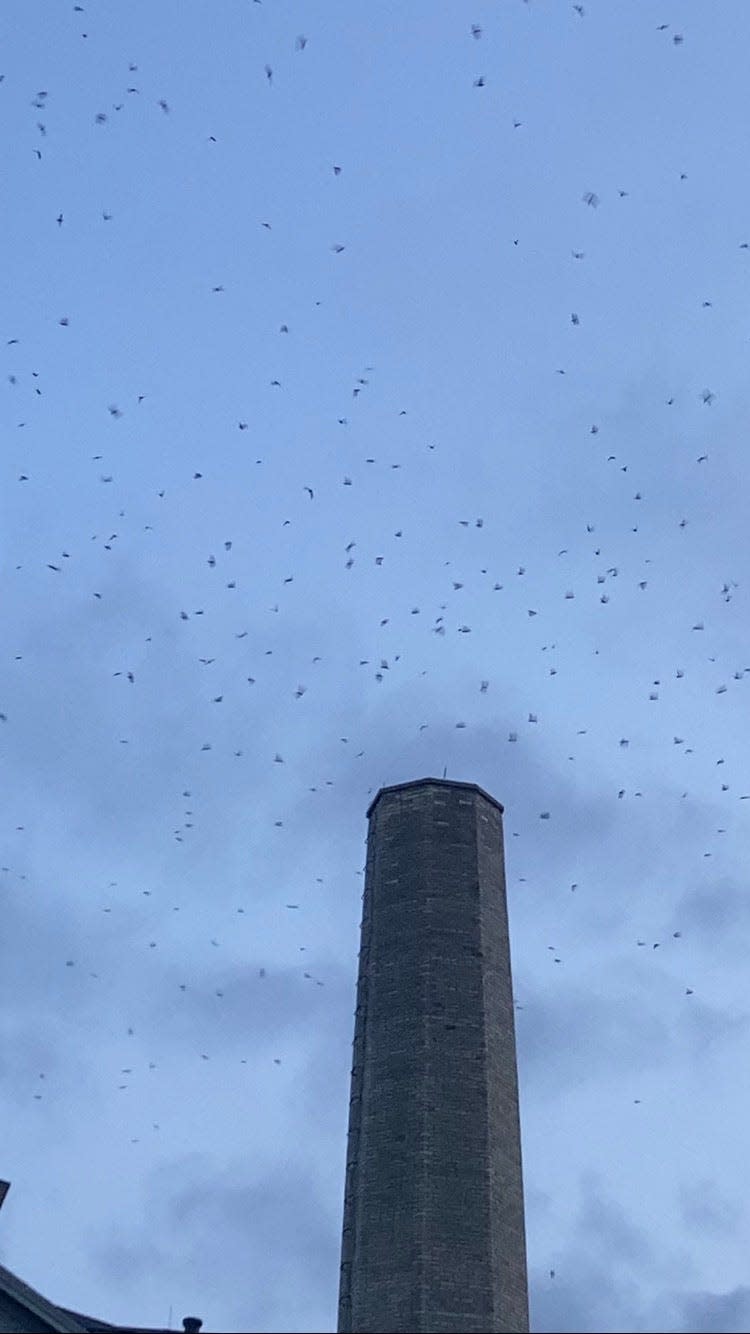Viewpoint: A spectacle of nature in our backyard: Thousands of birds return to Notre Dame
As spring returns to Indiana, the snow melts away, trees begin to leaf out, and flowers bloom. Spring sends us outside once again, finally in T-shirts, enjoying our parks and gardens. For me, the beginning of spring means I’ll be spending each evening sitting on the lawn outside an old industrial chimney, scanning the skies, and waiting.
Columba Hall, one of the oldest buildings on Notre Dame’s campus, is home to retired Brothers of the Holy Cross. In the spring, its chimney becomes another kind of home —a roost site for hundreds or thousands of chimney swifts. Chimney swifts are small birds that display a behavior called roosting, which means they gather in large numbers to sleep for the night. At sunset, the swifts begin to gather, first in small numbers, then more and more until a mass of hundreds of tiny birds fill the air, forming an almost tornado-like vortex as they swoop and swirl above the chimney. Then, they begin to plummet inside, streaming into the chimney until the sky is still once more. Inside the chimney, the swifts cling to the walls, digging in with their talons and propping themselves up with the exposed spines on their tail feathers that have given them their genus name chaetura, meaning “spike-tailed.” They huddle close together, layering themselves on the wall.

I have worked with swifts since 2016 and have monitored the Columba Hall roost since spring 2021. Each night as the swifts funnel into the chimney, I count how many are entering the roost. I’ve recorded up to 2,400 birds inside the chimney in a single night! Comparing Columba Hall to other spring chimney swift roosts, I found that our chimney was the second largest reported spring roost in the United States out of the 286 other roost sites I examined. In the fall, our numbers were also quite impressive — 32nd largest out of the 1,172 other reported roosts.
Despite the thousands of birds gathering nightly on the Notre Dame campus, most people weren’t aware the roost existed. The few that had spotted the huge mass of birds entering the chimney often didn’t know what they were seeing — many thought they were bats, or on one memorable occasion, giant bugs. But once they learned what was happening, they were charmed by the swifts.
Chimney swifts are migratory, breeding in North America in the summer and wintering in South America. Roosts are thought to serve an important function as stopover sites during spring and fall migration — places where the birds can rest, forage, and rebuild energy reserves before continuing on their journey. Swifts continue to roost in the breeding season as well, likely joining roosts for the warmth and protection that the large flocks and insulated chimneys provide. These old chimneys might not look like much from the outside, but they are important habitat for these little birds.
According to Partners in Flight, a leading bird conservation agency, chimney swifts are considered “a common bird in steep decline.” This means that, although they might still be numerically abundant, their populations have been proportionally crashing. They estimate that chimney swift populations declined by 67% between 1970 and 2014, and it’s predicted that it will take only 18 years for the population of chimney swifts in our area to fall by another 50%.
It's thought that loss of roost sites might be implicated in their decline, so identifying and preserving roost sites is an important part of working to conserve chimney swifts. In addition to the roost at Columba Hall, swifts have been reported roosting in a school chimney in Elkhart, and sometimes have been spotted roosting at Le Mans Hall at Saint Mary’s College, too. The fact that we have such large roosts in this area is an exciting opportunity to observe the swifts, learn more about their roosting behaviors, and do our part in preserving this species.
For the human audience, roosting is also beautiful to watch. In Portland, Oregon, where I began working with swifts, local residents would come out each night to watch the swifts enter their roost. When the final swift dropped into the chimney, the crowd almost always broke into applause. The swifts are merely turning in for bedtime, but we seem to recognize something more in what they have accomplished — a marvel of wings and air beneath a sunset-painted sky.
So as spring unfolds around us, I encourage you to keep your eyes and ears open to the warblers returning to the woods, the osprey returning to the lakes and rivers — and of course, the swifts returning to the chimneys. If you have the chance, consider stopping by one of our local roost sites, and enjoy a true spectacle of nature occurring right in our own backyard.
Charlotte Probst is a member of the University of Notre Dame Class of 2022 and an undergraduate research fellow at the Notre Dame Institute for Advanced Study.
This article originally appeared on South Bend Tribune: Chimney swifts, migratory birds, return to Notre Dame campus in spring

